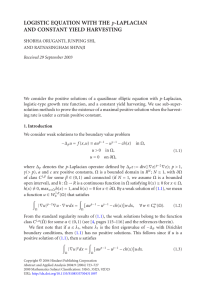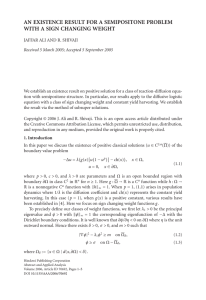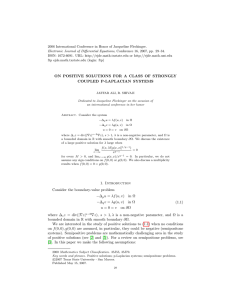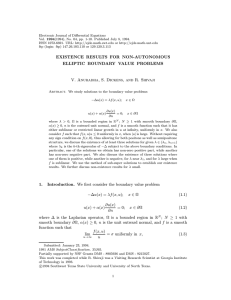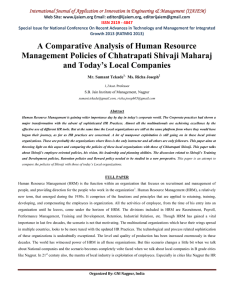EXISTENCE OF A POSITIVE SOLUTION FOR A SEMIPOSITONE PROBLEM p
advertisement
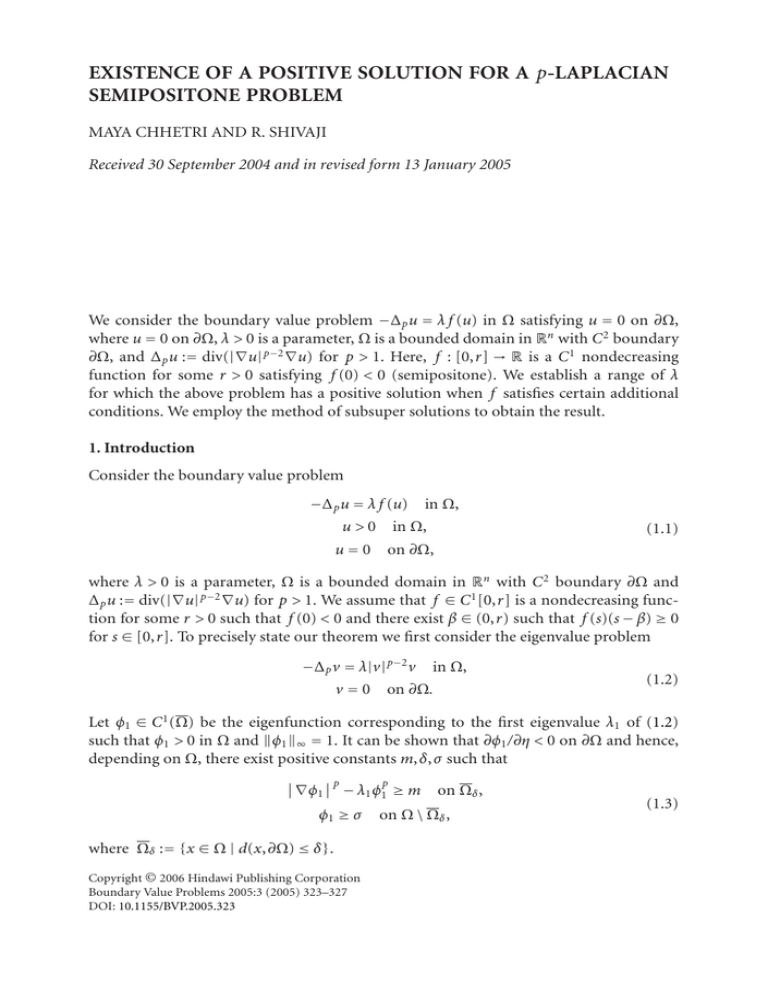
EXISTENCE OF A POSITIVE SOLUTION FOR A p-LAPLACIAN
SEMIPOSITONE PROBLEM
MAYA CHHETRI AND R. SHIVAJI
Received 30 September 2004 and in revised form 13 January 2005
We consider the boundary value problem −∆ p u = λ f (u) in Ω satisfying u = 0 on ∂Ω,
where u = 0 on ∂Ω, λ > 0 is a parameter, Ω is a bounded domain in Rn with C 2 boundary
∂Ω, and ∆ p u := div(|∇u| p−2 ∇u) for p > 1. Here, f : [0,r] → R is a C 1 nondecreasing
function for some r > 0 satisfying f (0) < 0 (semipositone). We establish a range of λ
for which the above problem has a positive solution when f satisfies certain additional
conditions. We employ the method of subsuper solutions to obtain the result.
1. Introduction
Consider the boundary value problem
−∆ p u = λ f (u)
in Ω,
u > 0 in Ω,
(1.1)
u = 0 on ∂Ω,
where λ > 0 is a parameter, Ω is a bounded domain in Rn with C 2 boundary ∂Ω and
∆ p u := div(|∇u| p−2 ∇u) for p > 1. We assume that f ∈ C 1 [0,r] is a nondecreasing function for some r > 0 such that f (0) < 0 and there exist β ∈ (0,r) such that f (s)(s − β) ≥ 0
for s ∈ [0,r]. To precisely state our theorem we first consider the eigenvalue problem
−∆ p v = λ|v | p−2 v
in Ω,
v = 0 on ∂Ω.
(1.2)
Let φ1 ∈ C 1 (Ω) be the eigenfunction corresponding to the first eigenvalue λ1 of (1.2)
such that φ1 > 0 in Ω and φ1 ∞ = 1. It can be shown that ∂φ1 /∂η < 0 on ∂Ω and hence,
depending on Ω, there exist positive constants m,δ,σ such that
∇φ1 p − λ1 φ p ≥ m
1
φ1 ≥ σ
where Ωδ := {x ∈ Ω | d(x,∂Ω) ≤ δ }.
Copyright © 2006 Hindawi Publishing Corporation
Boundary Value Problems 2005:3 (2005) 323–327
DOI: 10.1155/BVP.2005.323
on Ωδ ,
on Ω \ Ωδ ,
(1.3)
324
Positive solution for p-Laplacian semipositone problems
We will also consider the unique solution, e ∈ C 1 (Ω), of the boundary value problem
−∆ p e = 1
in Ω,
(1.4)
e = 0 on ∂Ω
to discuss our result. It is known that e > 0 in Ω and ∂e/∂η < 0 on ∂Ω. Now we state our
theorem.
Theorem 1.1. Assume that there exist positive constants l1 ,l2 ∈ (β,r] satisfying
(a) l2 ≥ kl1 ,
(b) | f (0)|λ1 /m f (l1 ) < 1, and
p −1
p −1
(c) l2 / f (l2 ) > µ(l1 / f (l1 )),
1/(p−1)
(p/(p − 1))σ (p−1)/ p e∞ and µ = µ(Ω) = (pe∞ /(p − 1)) p−1 (λ1 /
where k = k(Ω) = λ1
σ p ). Then there exist λ̂ < λ∗ such that (1.1) has a positive solution for λ̂ ≤ λ ≤ λ∗ .
Remark 1.2. A simple prototype example of a function f satisfying the above conditions
is
f (s) = r (s + 1)1/2 − 2 ;
0 ≤ s ≤ r4 − 1
(1.5)
when r is large.
Indeed, by taking l1 = r 2 − 1 and l2 = r 4 − 1 we see that the conditions β(= 3) < l1 < l2
and (a) are easily satisfied for r large. Since f (0) = −r, we have
f (0)λ1
=
λ1
.
m(r − 2)
m f l1
(1.6)
Therefore (b) will be satisfied for r large. Finally,
p −1
p −1
r4 − 1
(r − 2)
r 4p−3
∼
=
∼ r 2p−3
p −1
p −1 2
r 2p
l1 / f (l1 )
r2 − 1
r −1
l2 / f (12 )
(1.7)
for large r and hence (c) is satisfied when p > 3/2.
Remark 1.3. Theorem 1.1 holds no matter what the growth condition of f is, for large
u. Namely, f could satisfy p-superlinear, p-sublinear or p-linear growth condition at
infinity.
It is well documented in the literature that the study of positive solution is very challenging in the semipostone case. See [5] where positive solution is obtained for large λ
when f is p-sublinear at infinity. In this paper, we are interested in the existence of a
positive solution in a range of λ without assuming any condition on f at infinity.
We prove our result by using the method of subsuper solutions. A function ψ is said
to be a subsolution of (1.1) if it is in W 1,p (Ω) ∩ C 0 (Ω) such that ψ ≤ 0 on ∂Ω and
Ω
|∇ψ | p−2 ∇ψ · ∇w ≤
Ω
λ f (ψ)w
∀w ∈ W,
(1.8)
M. Chhetri and R. Shivaji 325
where W = {w ∈ C0∞ (Ω) | w ≥ 0 in Ω} (see [4]). A function φ ∈ W 1,p (Ω) ∩ C 0 (Ω) is said
to be a supersolution if φ ≥ 0 on ∂Ω and satisfies
Ω
|∇φ|
p −2
∇φ · ∇w ≥
Ω
λ f (φ)w
∀w ∈ W.
(1.9)
It is known (see [2, 3, 4]) that if there is a subsolution ψ and a supersolution φ of (1.1)
such that ψ ≤ φ in Ω then (1.1) has a C 1 (Ω) solution u such that ψ ≤ u ≤ φ in Ω.
For the semipositone case, it has always been a challenge to find a nonnegative subsolution. Here we employ a method similar to that developed in [5, 6] to construct a positive
subsolution. Namely, we decompose the domain Ω by using the properties of eigenfunction corresponding to the first eigenvalue of −∆ p with Dirichlet boundary conditions to
construct a subsolution. We will prove Theorem 1.1 in Section 2.
2. Proof of Theorem 1.1
p/(p−1)
First we construct a positive subsolution of (1.1). For this, we let ψ = l1 σ p/(1− p) φ1
1/(p−1)
∇φ1 ,
Since ∇ψ = p/(p − 1)l1 σ p/(1− p) φ1
Ω
.
|∇ψ | p−2 ∇ψ.∇w
=
p
p−1
=
p
p−1
=
p
p−1
×
=
Ω
l1 σ
p/(1− p)
l1 σ
p/(1− p)
l1 σ
Ω
p
=
Ω
p −1 Ω
p/(1− p)
p −1 Ω
l1 σ p/(1− p)
p −2
φ1 ∇φ1 ∇φ1 · ∇w
∇φ1 | p−2 ∇φ1 ∇ φ1 w − w ∇φ1
∇φ1 p−2 ∇φ1 .∇ φ1 w −
p
p−1
l1 σ
p/(1− p)
p −1
∇φ1 p w
p−1
×
p −1 |∇φ1 | p w
p
p−1
l1 σ p/(1− p)
p −1 Ω
p −2
λ1 φ1 by (1.2)
φ1 φ1 w −
p
l1 σ p/(1− p)
p−1
p −1
p −1 p p
λ1 φ1 − ∇φ1 w
Ω
∀w ∈ W.
(2.1)
Thus ψ is a subsolution if
p
p−1
l1 σ p/(1− p)
p −1 Ω
p
λ1 φ1 − ∇φ1 w ≤ λ
p
Ω
f (ψ)w.
(2.2)
Positive solution for p-Laplacian semipositone problems
326
On Ωδ
∇φ1 p − λφ p ≥ m
(2.3)
1
and therefore
p
p−1
l1 σ p/(1− p)
p −1 p
λ1 φ1 − ∇φ1 p
≤ −m
p
p−1
l1 σ p/(1− p)
p −1
≤ λ f (ψ)
(2.4)
if
m p/(p − 1) l1 σ p/(1− p)
λ ≤ λ̃ :=
f (0)
p −1
.
(2.5)
On Ω \ Ωδ we have φ1 ≥ σ and therefore
p/(p−1)
ψ = l1 σ p/(1− p) φ1
≥ l1 σ p/(1− p) σ p/(p−1) = l1 .
(2.6)
Thus
p
p−1
l1 σ p/(1− p)
p −1 p
λ1 φ1 − ∇φ1 p
≤ λ f (ψ)
(2.7)
if
λ1 p/(1 − p)l1 σ p/(1− p)
λ ≥ λ̂ :=
f l1
p −1
.
(2.8)
We get λ̂ < λ̃ by using (b). Therefore ψ is a subsolution for λ̂ ≤ λ ≤ λ̃.
Next we construct a supersolution. Let φ = l2 /(e∞ )e. Then φ is a supersolution if
Ω
∇φ p−2 ∇φ.∇w =
Ω
l2
e ∞
p −1
w≥λ
Ω
f (φ)w
∀w ∈ W.
(2.9)
But f (φ) ≤ f (l2 ) and hence φ is a super solution if
λ ≤ λ :=
p −1
l2
p −1 e ∞ f l 2
.
(2.10)
Recalling (c), we easily see that λ̂ < λ. Finally, using (2.1), (2.9) and the weak comparison
principle [3], we see that ψ ≤ φ in Ω when (a) is satisfied. Therefore (1.1) has a positive
solution for λ̂ ≤ λ ≤ λ∗ where λ∗ = min{λ̃,λ}.
M. Chhetri and R. Shivaji 327
References
[1]
[2]
[3]
[4]
[5]
[6]
M. Chhetri, D. D. Hai, and R. Shivaji, On positive solutions for classes of p-Laplacian semipositone
systems, Discrete Contin. Dynam. Systems 9 (2003), no. 4, 1063–1071.
P. Drábek and J. Hernández, Existence and uniqueness of positive solutions for some quasilinear
elliptic problems, Nonlinear Anal. Ser. A: Theory Methods 44 (2001), no. 2, 189–204.
P. Drábek, P. Krejčı́, and P. Takáč, Nonlinear Differential Equations, Chapman & Hall/CRC Research Notes in Mathematics, vol. 404, Chapman & Hall/CRC, Florida, 1999.
Z. M. Guo and J. R. L. Webb, Large and small solutions of a class of quasilinear elliptic eigenvalue
problems, J. Differential Equations 180 (2002), no. 1, 1–50.
D. D. Hai and R. Shivaji, An existence result on positive solutions for a class of p-Laplacian systems,
Nonlinear Anal. 56 (2004), no. 7, 1007–1010.
S. Oruganti and R. Shivaji, Existence results for classes of p-Laplacian semipositone equations,
submitted.
Maya Chhetri: Department of Mathematical Sciences, University of North Carolina at Greensboro,
NC 27402, USA
E-mail address: maya@uncg.edu
R. Shivaji: Department of Mathematics and Statistics, Mississippi State University, Mississippi
State, MS 39762, USA
E-mail address: shivaji@math.msstate.edu
